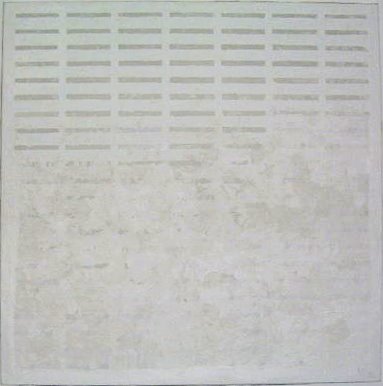Kandinsky notes that
"the music is the art which not uses its means to represent the phenomena of nature but to express the spiritual life of the artist and to create a clean life of the musical sounds". My step concerns such a research. Not that I assimilate my painting to a musical "composition": it is not a question "to make hear" while giving to see - what absurd and would be virtually lost in advance. On the other hand, the objective is to
cause a feeling, an emotion, by using the means of painting without imitating nature. And by reducing the things to essence.
That it is pressed on a geometric abstraction or - more rarely - expressionnist, my painting is deliberately
quiet : far from a generating agitation external of interferences, it seeks to cause a state of
calms and
return on oneself. By running the counter to a world in a hurry but amnesic, my painting bets over the moment present: it does not imitate the past nor does not propose answers for the future. These references and these answers are of each one of us.More than one simple image, too informative, directing, or too quickly décodable, each fabric is a support with the escape,
a window open on an interior voyage. It is not delivered completely to the first reading and request a certain attention to its spectator (on this subject, it is important to note that my work is very difficult to photograph... and to see even more on Internet!). Agnès Martin (1912 - 2004) said of her work:
"Whoever is able to sit down two hours vis-a-vis with the desert for simply contemplating it understands my painting". I will take again readily this formula.
Neither representative nor completely abstract, my paintings are almost always inspired by a place, one moment: contrary to the hyperrealism without being for as much (in my eyes) purely abstract, one could speak about
infrarealism". A radical, demanding step sometimes, with the service of the emotion.The technique developed here rests on the repetition of signs - the square, the line - which, by their juxtaposition, create a tension with the manner of a screen of printing works. One can in this direction being tempted to make a comparison with the step of Roy Lichtenstein which diverts the techniques of the impression by producing its series of "comics". But more basically, one can seek a parallel with the
music - once again - and particularly with the repetitive music and the serial music. It is the repetition continues "almost" even sign, its quasi chant, which installs an environment, creates a vibration, installs a resonance. The choice of the site of the fabric in the space in which it is hung is determining: the sources of light make it live, cause tensions, reflections, oppositions mat/satiné which form integral part of the composition. Each hour of the day, each change of light nourishes the fabric differently, brings a new lighting - in all the directions of the term - and causes a new reading.
